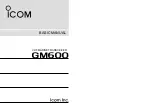
EN
15
14
perform a range check. All Spektrum aircraft transmitters incorporate a range
testing system, which reduces the output power to allow a range check.
1.
With the model resting on the ground, stand 30 paces (approx. 90 feet/28
meters) away from the model.
2.
Face the model with the transmitter in your normal flying position and put
your transmitter into range test mode. This causes reduced power output
from the transmitter.
3.
You should have total control of the model in range test mode at 30 paces
(90 feet/28 meters).
4.
If control issues exist, call Horizon Product Support for further assistance.
Advanced Range Testing
The Standard Range Testing procedure is recommended for most sport aircraft.
For sophisticated aircraft that contain significant amounts of conductive materials
(e.g. turbine powered jets, some types of scale aircraft, aircraft with carbon
fuselages, etc.), the following advanced range check will confirm that all remote
receivers are operating optimally and that the installation (position of the receiv-
ers) is optimized for the specific aircraft. This Advanced Range Check allows the
RF performance of each remote receiver to be evaluated and to optimize the
locations of each individual remote receiver.
IMPORTANT: If you don’t have a telemetry-capable transmitter, you can
connect a Flight Log to the Bind/Prog port on the receiver.
1.
Standing 30 paces away from the model, face the model with the transmitter
in your normal flying position.
2.
Put your transmitter in range test mode. Range test mode reduces the power
output from the transmitter.
3.
Have someone position the model in various orientations (nose up, nose
down, nose toward the transmitter, nose away from the transmitter, etc.).
4.
Observe the telemetry on your transmitter. Note any orientations that cause
higher fade or hold values. Perform this step for at least one minute.
5.
Re-position any remote receivers as necessary.
6.
Have your helper position the model in various orientations (nose up,
nose down, nose toward the Tx, nose away from the Tx, etc.) observe the
telemetry on your transmitter or while your helper watches the Flight Log
noting any correlation between the aircraft’s orientation and frame losses.
Do this for 1 minute. The timer on the transmitter can be used here. For
giant-scale aircraft, it’s recommended that the airplane be tipped up on its
nose and rotated 360 degrees for one minute then the data recorded. Next
place the airplane on its wheels and do a second test, rotating the aircraft
in all directions for one minute.
7.
After one minute, a successful range check will have less than ten re-
corded frame losses. Scrolling the Flight Log through the antenna fades (A,
B, L, R) allows you to evaluate the performance of each receiver. Antenna










































